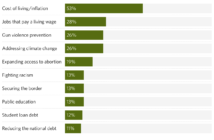The Article below was published in Vol. 136, Issue 7 of the Lake Forest College Stentor on April 2, 2021.
Veronika Knych ’23
Staff Writer
Switching to remote learning hasn’t been easy for anyone, teachers and students of all ages included. Those involved with special education must assimilate to a whole new routine of a manageable school schedule. How special education teachers and students have adapted to learning through a screen might lend insights into how others can successfully manage this new learning environment.
Indra Williams, a special education assistant at Glenbrook North High School in Northbrook, Illinois, uses a number of platforms to stay connected with her special needs students on a daily basis, including Zoom, Google Classroom, Google Hangouts, and EdPuzzle. Many of her students are on the spectrum, often struggling with general social skills and paying attention in class.
Williams says it was difficult in the beginning but as her students became accustomed to the online platform, the transition to remote learning has made them stronger technologically. “My student has done well,” Williams says about one particular student. “Zoom taught him all the necessary things he needed to do.”
In the beginning of the online school year, Williams would use the private chat feature on Zoom to ask her student if they wanted to participate in class. Since her students have gotten used to remote learning, they’ve become more comfortable speaking aloud in class and answering questions.
Sometimes she and her students became frustrated with remote learning since it was difficult to tell if her students were off-task or paying attention when they shared their screen. Some of her students dislike remote learning because they miss their friends and she, too, misses the social interactions with her students.
Still, Williams noted there were some benefits to remote learning, including the ability to offer more one-on-one attention and it seems some of her students are now experiencing fewer sensory issues. A few of her students have gone back to in-person learning and Williams says they’re doing well.
Angela Anetsberger experienced online learning first-hand as a parent of three elementary and middle school children, one of whom has a learning disability. When her children transitioned to online learning in March 2020, she says they were anxious about the change.
“I know the teachers tried to spend at least that last day before they came home with their iPads, kind of talking to them about the technology and how to use it, and that was where a lot of the anxiety came from,” Anetsberger says. “No one knew how to use Zoom or knew how to do anything.”
To help make the transition for everyone easier, her children’s teachers would email Anetsberger with detailed instructions on how to navigate the classroom’s platform.
“There was just a lot of confusion before we even started with regular Zoom calls,” Anetsberger says. “There were a couple of times where we had some technical difficulties.”
Once they all got into a new daily routine, her children started to get the hang of it, including Austin, her youngest who is a first grade student with an Individualized Education Program (IEP).
Before fall classes began, Austin’s teachers used the summer to plan a school schedule that would work for him to make sure he got all the help he needed during the school day, according to Anetsberger.
“They had a main general education schedule and then they had one for him, specifically,” she adds. “Most students got the one schedule that fit all in the class and the kids who had an IEP had a second schedule.”
While Anetsberger is currently working from home, her work schedule and her children’s schedules did not often coincide with each other. While Austin was learning remotely, he required someone to sit beside him to help him stay focused and keep track of time.
Aleksandra Kijowska, Austin’s aide, would work with Austin during his school day.
“I’ve noticed that giving Austin warnings when he starts to get goofy has helped him focus more,” Kijowska says when Austin would become unfocused or get distracted. “Austin also does a great job focusing when he enjoys what he is learning.”
Like many young children, Austin would get frustrated if things didn’t go his way, she adds. “If I corrected him or the teacher at any point, he would get very upset and shut down at times,” Kijowska says. “We practiced breathing techniques and practiced how to communicate when things get difficult. Talking his problems out seemed to really help Austin significantly.”
Not everyone has gotten the hang of remote learning, even a year later. In some cases, schools have failed to accommodate students with learning disabilities. That’s been Indra Williams daughter’s experience, Elise Williams, who is a sophomore at the University of Wisconsin-Eau Claire. According to Elise, online school has not been accommodating to her learning disabilities.
Elise feels that while she has made it through the semester, it was tough keeping in contact with teachers and she’s been unable to learn to her full potential, due to the lack of help and understanding of her learning disability through remote learning.
“It’s impossible to focus when teachers are talking,” Elise says about her transition to online school. “There’s less stimulation so it’s harder to focus.”
She wishes there were subtitles while her professors spoke in class because it would be easier to follow along. “It’s easier to disengage when your professor is in a screen instead of actually interacting with you in a space,” Elise adds.
For Elise, keeping track of time and assignments during the school year was a challenge and she was frustrated when she accidentally missed school work because of her ASD (Autism Spectrum Disorder) and ADHD (Attention Deficit Hyperactivity Disorder).
“My grade definitely does not reflect my understanding of the material,” says Elise, who notices schools and curriculums are designed somewhat homogeneously and do not take into consideration that not all students learn the same way, including online.
“I feel like modern educational systems have this very specific approach where they want to streamline all these kids into a very specific way of doing things,” Elise says. “It hurts people who have different brains. There’s a lot of strengths that I get from my disability. I get a lot of passion. I just wish they understood that there should be some flexibility in education.”


